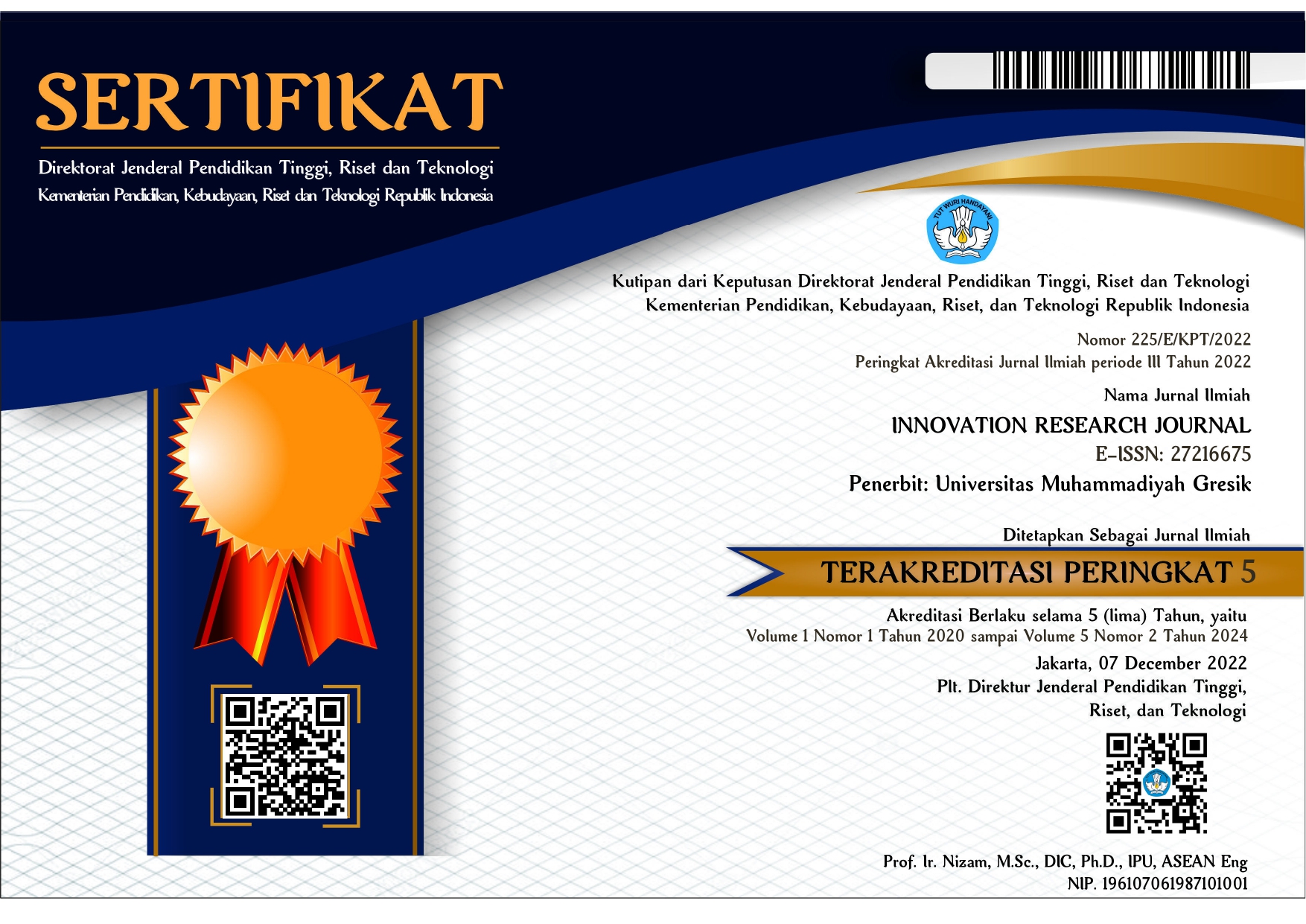The Effect of Stress Due to Fatigue, Flight Duration, and Situation Awareness on Pilot Flight Performance
The Effect of Stress Due to Fatigue, Flight Duration, and Situation Awareness on Pilot Flight Performance
DOI:
https://doi.org/10.30587/innovation.v6i1.9501Keywords:
Flight performance, fatigue, flight duration, and situational awarenessAbstract
This study aims to examine several factors that influence stress caused by fatigue, flight duration, and situational awareness that affect pilot flight performance. This study uses a literature research method by collecting and analyzing literature found in various journals, scientific articles, and related literature sources. This study will identify that fatigue, situational awareness, and long flight duration are factors that cause increased stress levels, which significantly disrupt cognitive abilities, decision making, and concentration in pilots during flights. When pilots have a high level of situational awareness, it can have an impact as a mitigation factor that can reduce the negative impact of stress on pilot flight performance. The findings of this research and literature review are expected to provide a basis for developing strategies for stress management and for improving situational awareness that has an impact on flight safety and security because it affects pilot performance for decision making in emergency situations.
Keywords: Flight performance, fatigue, flight duration, and situational awareness
References
Bendak, S., & Rashid, H. S. J. (2020). Fatigue in aviation: A systematic review of the literature. In International Journal of Industrial Ergonomics(Vol. 76). ElsevierB.V. https://doi.org/10.1016/j.ergon.2020.102928
Boksem, M. A. S., & Tops, M. (2008). Mental fatigue: Costs and benefits. In Brain Research Reviews (Vol. 59, Issue 1,pp. 125-139) https://doi.org/10.1016/j.brainresrev.2008.07.001
Cahill, J., Cullen, P., Anwer, S., Wilson, S., & Gaynor, K. (2021). Pilot Work Related Stress (WRS), Effects on Wellbeing and Mental Health, and Coping Methods. International Journal of Aerospace Psychology, 31(2), 87–109.
https://doi.org/10.1080/24721840.2020.1858714
Caldwell, J. A. (2012). Crew Schedules, Sleep Deprivation, and Aviation Performance. Current Directions in Psychological Science, 21(2), 85–89. https://doi.org/10.1177/0963721411435842
Enoka, R. M., & Duchateau, J. (2008). Muscle fatigue: What, why and how it influences muscle function. In Journal of Physiology (Vol. 586, Issue 1, pp. 11–23). https://doi.org/10.1113/jphysiol.2007.139477
Fiedler, E. R., P. Della Rocco, D. J. Schroeder, and K. T. Nguyen. 2000. “The Relationship Between Aviators’ Home-Based Stress to Work Stress and Self-Perceived Performance.” FAA Office of Aviation Medicine Reports DOT-FAA-AM-00-32. 7.
Hsberg, E. A. Ê. (2000). Dimensions of fatigue in different working populations. In Scandinavian Journal of Psychology.
International Civil Aviation Organisation 2020. [ICAO]. Competency Based Training and Assessment (CBTA) ICAO DOC 9868, Procedures for Air Navigation Services
International Civil Aviation Organization 2019. ICAO Safety Report 2019 Edition https://www.icao.int/safety/Documents/ ICAO_SR_2019_29082019.pdf
Keinan, G. 1987. “Decision Making under Stress: Scanning of Alternatives under Controllable and Uncontrollable Threats.” Journal of Personality and Social Psychology 52 (3): 639–644. doi:10.1037/0022-3514.52.3.639. Keller, J.,
F. A. Mendonca, M. Suckow, and B. G. Dillman. 2019. Transforming the professional flight program curriculum: Justification, process, and future development. Paper presented at the Polytechnic Summit 2019, Menomonie, Wisconsin. K
Mayo, A. (2000). The role of employee development in the growth of intellectual capital. Personnel Review, 29(4), 521–533. https://doi.org/10.1108/00483480010296311
Nater, U. M. (2018). The multidimensionality of stress and its assessment. In Brain, Behavior, and Immunity (Vol. 73, pp. 159–160). Academic Press Inc. https://doi.org/10.1016/j.bbi.2018.07.018
Nur Cahyanto, Taufik, Respati, H., & Natsir, M. (2020). The Effect of Individual Capability, Individual Motivation, Organizational Climate, and Transformational Leadership on Pilot Performance. East African Scholars Journal of Economics, Business and Management, 3(12), 911–919. https://doi.org/10.36349/easjebm.2020.v03i12.002
Phillips, R. O. (2021). What is fatigue and how does it affect the safety performance of human transport operators? Fatigue in Transport Report I
Rosekind, M. R., Miller, D. L., Gregory, K. B., Software, S., Smith, R. M., Weldon, K. J., Co, E. L., & Mcnally, K. L. (1994). Fatigue in Operational Settings: Examples from the Aviation Environment. In HUMAN FACTORS (Vol. 36, Issue 2).
Setyawan, I., & Budiman, A. (2021). Kajian Beban Kerja Pilot Terhadap Terciptanya Kinerja Pilot Dalam Menunjang Keselamatan Penerbangan (Studi Kasus Maskapai X) Pilot Workload Study on the Creation of Pilot Performance in Supporting Aviation Safety (Case Study Of Airline X). In Jurnal Ilmiah Kedirgantaraan (Vol. 18). http://knkt.dephub.go.id/knkt/ntsc_home/Medi
Van Leeuwen, W. M. A., Kircher, A., Dahlgren, A., Lützhöft, M., Barnett, M., Kecklund, G., & Åkerstedt, T. (2013). Sleep, sleepiness, and neurobehavioral performance while on watch in a simulated 4 hours on/8 hours off maritime watch system. Chronobiology International, 30(9), 1108–1115. https://doi.org/10.3109/07420528.2013.800874
Venus, M., & Holtforth, M. grosse. (2022). Interactions of International Pilots’ Stress, Fatigue, Symptoms of Depression, Anxiety, Common Mental Disorders and Wellbeing. International Journal of Aviation, Aeronautics, and Aerospace, 9(1). https://doi.org/10.15394/ijaaa.2022.1667
Wibawanti, R., Agustina, A., Muda, M. M., & Werdhani, R. A. (2021). Upaya Pengelolaan Fatigue Pada Penerbang Dengan Aktivitas Fisik, Latihan Fisik Dan Waktu Tidur
Wojcik, D. Z., C. J. A. Moulin, and A. Fernandez. 2021. “Assessment of Metacognition in Aviation Pilot Students during Simulated Flight Training of a Demanding Maneuver.” Applied Ergonomics 95: 103427. doi:10.1016/j.apergo.2021.103427.
Young, R. D. 2008. Quality of Life Indicator Systems-Definitions, Methodologies, Uses, and Public Policy Decision Making. Columbia: Institute for Public Service and Policy Research, University of South Carolina.
Young, M., and N. Stanton. 2002. “Malleable Attentional Resources Theory: A New Explanation for the Effects of Mental Underload on Performance.” Human Factors 44 (3): 365–375. doi:10.1518/0018720024497709.
Xiao, Y. M., Z. M. Wang, M. Z. Wang, and Y. J. Lan. 2005. “The Appraisal of Reliability and Validity of Subjective Workload Assessment Technique and NASA-Task Load Index.” Zhonghua Lao Dong Wei Sheng Zhi ye Bing za Zhi=Zhonghua Laodong Weisheng Zhiyebing Zazhi=Chinese Journal of Industrial Hygiene and Occupational









